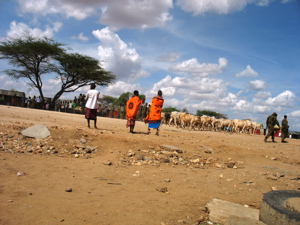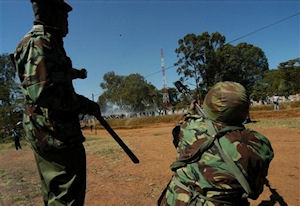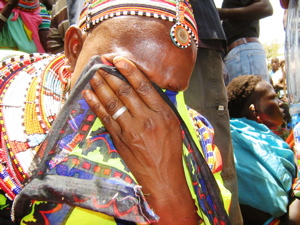 For more than three weeks now, the Kenyan government has been engaged in a brutal campaign of violence against the indigenous Samburu people in north central Kenya.
For more than three weeks now, the Kenyan government has been engaged in a brutal campaign of violence against the indigenous Samburu people in north central Kenya.
According to Cultural Survival (CS), the government, who claims to be chasing after “cattle bandits”, has “strafed the unarmed villagers with machine guns” from the air and “used clubs to beat them on the ground.” Further reports indicate that at least nine bombs have been dropped on Samburu villages, and a yet-to-be-identified caustic chemical was sprayed on group of children who were seeking refuge in the bush.
 The government has also confiscated all of the Samburu’s cattle, leaving them without any access to food.
The government has also confiscated all of the Samburu’s cattle, leaving them without any access to food.
All of this is despite the court order obtained last month that barred the operation.
It is not known how many Sambura have been killed, as military forces are preventing outsiders from entering the region, and they have seized all communications equipment. However, CS reports that at least 2,000 Samburu have been displaced.
And there is grave danger of more attacks on the way. Raphael Letimelo, a member of parliament for the Samburu district, says, “There have been reports and threats of possible mass executions and removal from of indigenous people from their traditional homelands throughout the Samburu District in the next few weeks.”
 “At first, the community thought the police were here to help us and ran out to greet them,” says Sammy Lepurdati, a Samburu villager present during the attacks. “When they initially started shooting, everyone tried to convince them they were making a mistake, but instead the police kept circling the bomas in helicopters, firing deliberately at innocent people. It was a nightmare. People were screaming, running in every direction. Those who survived fled to the bush and nearby mountains.”
“At first, the community thought the police were here to help us and ran out to greet them,” says Sammy Lepurdati, a Samburu villager present during the attacks. “When they initially started shooting, everyone tried to convince them they were making a mistake, but instead the police kept circling the bomas in helicopters, firing deliberately at innocent people. It was a nightmare. People were screaming, running in every direction. Those who survived fled to the bush and nearby mountains.”
“The government claims it was trying to flush out bandits and seize illegal guns used in cattle raids that are common in the area (and guns were in fact seized in other areas),” CS explains. “But the particular cattle raid that prompted this series of attacks appears to have been staged.”
A Kenyan military officer has released documents “showing that these attacks were planned months in advance, and there is explicit mention of the intention to ‘bring these people into the modern era.'”
However, this appears to be a tertiary motive to the governments desire “to clear out indigenous tribes to make way for burgeoning development in the area.” CS Continues, “The Chinese are funding a major highway through the area to allow transport of oil from their fields in Ethiopia to Kenya’s ports, and they have dramatically increasing trade with Kenya to $1 billion a year. Profits from poaching also may be involved. In the three weeks since the attacks, 57 elephants have been poached in the area (greater than the number taken in the country as a whole over the 12 months of 2007). China is the top market for illegal ivory, and the kickbacks from that trade may be prompting some Kenyan government officials to remove local environmental control.”
“The Samburu maintain several wildlife conservancies in the area, and part of the police action included shutting all of them down” and further confiscating all anti-poaching gear they could find.
 “As bad as the attacks have been, for the Samburu the more devastating aspect will likely be the loss of their cattle, which are the basis of their culture and their economy. “Without milk from their cattle, the community members will die,” Dan Letoiya, Director of West Gate Wildlife Conservancy stated. “We are experiencing another severe drought and this is their only source of protein and liquid. The milk from their livestock makes up 90 percent of their dietary intake.”
“As bad as the attacks have been, for the Samburu the more devastating aspect will likely be the loss of their cattle, which are the basis of their culture and their economy. “Without milk from their cattle, the community members will die,” Dan Letoiya, Director of West Gate Wildlife Conservancy stated. “We are experiencing another severe drought and this is their only source of protein and liquid. The milk from their livestock makes up 90 percent of their dietary intake.”
Photo Credit: Cultural Survival
Please disttribute this information to your networks, and send a letter in support of the Samburu to the president of Kenya, Mwai Kibaki, and other government officials, urging an end to this genocidal assault.
Addresses:
Hon. Mwai Kibaki, The President, Republic of Kenya, P.O. Box 30050 00100 – Harambee Avenue Nairobi, Kenya, Fax: +254-020-243620, Email: president@statehousekenya.go.ke
Right Hon. Raila Odinga, Prime Minister, Republic of Kenya, P.O. Box 30050 00100, Nairobi, Kenya, Email: contact@statehousekenya.go.ke
Hon. George Saitoti, Minister for Internal Security, Harambee Avenue, P.O. Box 30510, Nairobi 00200, Kenya, Tel: +254-020-227411
Major General Hussein Ali, Commissioner of Police, Kenya Police Headquarters, Vigilance House, Harambee Avenue, P.O. Box 30083, Nairobi, Kenya, Tel: +254-020-341411/6/8, Email: commissioner@police.go.ke, complaints@police.go.ke
Hon S. Amos Wako, Attorney General, State Law Office, Harambee Avenue, P.0. Box 40112, Nairobi, Kenya, Tel.: +254-020-227461
Kenya National Commission on Human Rights Chairperson Mrs. Jaoko e-mail haki@knchr.org
Hon. Martha W. Karua, E.G.H., M.P., Ministry of Justice, Haile Selassie Avenue, P.O. Box 56057, Nairobi, Kenya, Tel.: 254-20-224029, Email: ps-justice@justice.go.ke
Permanent Mission of Kenya to the United Nations in Geneva, Av. de la Paix 1-3, 1202 Genève, Switzerland, Fax: +41 22 731 29 05, E-mail: mission.kenya@ties.itu.int
Please also write to the embassies of Kenya in your respective
countries.

Indigenous Peoples are putting their bodies on the line and it's our responsibility to make sure you know why. That takes time, expertise and resources - and we're up against a constant tide of misinformation and distorted coverage. By supporting IC you're empowering the kind of journalism we need, at the moment we need it most.